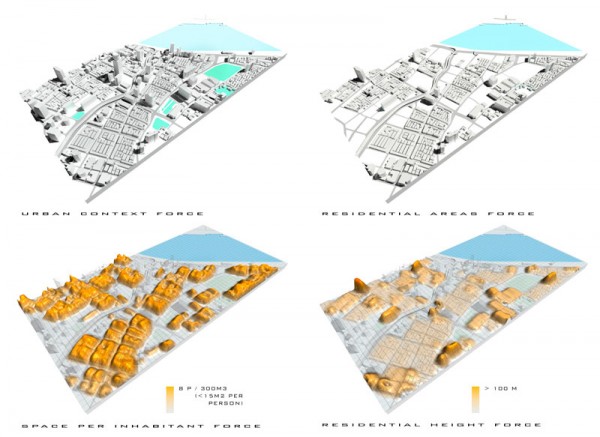Third place of the 2007 Housing Competition
Project by: Marcin Pilsniak
New Housing for Shanghai
The aim of this project is to explore possible solutions to housing problems in rapidly developing cities worldwide.
Shanghai was chosen as the location for this study because it is affected by extreme poverty, social segregation, and lack of housing developments. The city has two radically different faces; the rich and polished, and the poor and crammed, who live with a population density of less than 15 square meters per person. These problems are the result of a massive influx of people with very low income, who constitute over 60 per cent of its population. Two age groups are especially affected throughout the city; young adults, with little capital to invest, and elderly residents, that cannot continue working in the physically demanding labor market.
Within an environment as dynamic as Shanghai a flexible and adaptive housing project is required; a solution that allows natural organization, with a system of basic building blocks governed by a set of growth rules that continuously evolve according to their interaction with the environment.
Throughout the use of computer algorithms it is possible to generate a self-organizing urban structure of infinite complexity that responds to constant changes and urban forces. The result is a designed genotype or set of rules for a housing development, instead of a definitive product. This system can be applied to an infinite number of environments and produce radically different outcomes, specific to each location.
The design process involved the definition of six different algorithms from previously studied urban forces mapped onto a three dimensional model, as a set of dynamic surfaces that constitute the basic ecosystem for a residential district. The residential environment is not seen as ratios and surface areas, but as three dimensional spaces. In the Shanghai project the model was broken down into four main categories, including existing residential, new residential, commerce, and recreational areas.
The six ‘urban algorithms’ used in the project are commercial activity, transit system, boundaries, population density, building height, and recreational areas. The data generated by the algorithms is transformed into architecture by another set of rules that translates the information into building code for material, structural, and formal analysis.
The result is an ever-changing organism that responds to new demands while interacting with previous urban conditions.





















